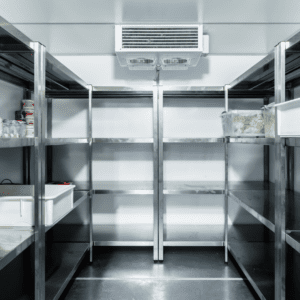You’ll find that maximizing your commercial walk in refrigerator isn’t just about cramming in as much as possible. Whether running a thriving restaurant or managing a wholesale operation, smart organization can dramatically improve your workflow, reduce waste, and protect your bottom line. From strategic layout planning to temperature zoning, there’s a science to optimizing your cold storage space—and the solutions you implement today can transform your operation’s efficiency tomorrow.
Strategic Layout Planning for Maximum Efficiency

Strategic planning is vital when designing your walk-in refrigerator’s layout, as it maximizes operational efficiency and food safety. Start by exploring shelf configuration options that position units along the perimeter walls, creating an unobstructed central aisle for smooth traffic flow.
Implement workflow optimization techniques by arranging frequently used items at easily accessible heights and locations. Make the most of your vertical space with multi-tiered shelving systems while maintaining proper air circulation.
Establish designated zones for different product categories to enhance organization and prevent cross-contamination. Position raw meats, prepared foods, and packaged goods in separate areas. Remember to implement clear labeling and FIFO rotation protocols.
This systematic approach to layout planning will streamline your operations, reduce waste, and help maintain health code compliance.
Temperature Zoning and Product Placement
Temperature zoning within your walk-in refrigerator is fundamental in preserving food quality and safety. You’ll achieve optimal storage by strategically placing temperature-sensitive items, with delicate products on upper shelves where monitoring is easier. Install temperature monitoring systems near your most critical storage zones, and position temperature sensors throughout different areas to guarantee consistent cooling.
Create distinct zones by storing produce closer to the entrance, where slightly warmer temperatures won’t affect quality. Place meat and seafood towards the back, where it’s consistently colder. Don’t overcrowd shelves, as this restricts airflow and creates temperature fluctuations. Remember that warm air rises, so consider this when arranging items vertically. Maintaining proper temperature zones extends product shelf life, reduces energy costs, and ensures food safety compliance.
Shelving Systems and Storage Equipment
Building on your temperature zoning strategy, the right shelving system forms the backbone of an efficient walk-in refrigerator. You’ll want to invest in rust-resistant shelf materials like stainless steel or heavy-duty plastic that can withstand moisture while remaining easy to clean and sanitize.
Choose adjustable shelving options to customize storage configurations based on your product mix. This flexibility helps you maximize vertical space and accommodate items of different sizes. When selecting shelves, guarantee they’re rated to handle the weight of your heaviest items to prevent dangerous collapses.
Remember to space your shelving units properly to maintain consistent airflow throughout the unit. Label your storage areas clearly and implement an organized system that simplifies inventory management while reducing cross-contamination risks.
Proper Airflow Management Techniques
Proper airflow management stands at the core of your walk-in refrigerator’s performance. To maintain consistent temperature monitoring and humidity control, you must guarantee unobstructed air circulation throughout your unit.
Start by raising your lowest shelves at least 6 inches from the floor, which enhances air movement and makes cleaning easier. Keep 2-3 inches of space between shelves and stored items to prevent cold air blockages. Don’t overcrowd your storage areas; this can create temperature inconsistencies and strain your cooling system.
Position your refrigeration unit strategically and avoid stacking products that might block its airflow. You’ll also want to conduct regular inspections for frost buildup or debris that could impede proper circulation. These simple yet effective practices will help maximize your unit’s efficiency and maintain food safety standards.
Inventory Control and Organization Methods

Efficient inventory management in your walk-in refrigerator begins with a systematic approach to organization and control. Implement strict stock rotation policies using the FIFO method to guarantee older products are used first, reducing waste and maintaining freshness. You must establish regular inventory auditing practices to track product movement and expiration dates.
Organize your space by creating designated zones for different product types and keeping meats on the bottom shelves to prevent cross-contamination. Install adjustable, rust-resistant shelving to maximize vertical storage while maintaining clear aisles for proper air circulation. Don’t forget to label everything clearly with expiration dates and storage requirements.
Keep your inventory organized by avoiding overcrowding and maintaining proper spacing between items. This strategy will improve workflow and help your refrigeration system operate more efficiently while certifying food safety compliance.
Safety and Compliance Standards
To maintain a safe and compliant commercial walk-in refrigerator, you must follow strict NSF standards and local health regulations. Guarantee proper door clearance requirements and maintain at least 6 inches between the floor and bottom shelves for effective cleaning.
Implement comprehensive food safety labeling systems that display product names, dates, and contents to prevent contamination risks and support efficient inventory management.
- Store raw meats on lower shelves with catch pans to prevent cross-contamination drips
- Install easy-to-read thermometers at eye level to monitor the 35-41°F temperature range
- Keep cleaning supplies and sanitizing stations near the entrance for immediate access
- Place high-traffic items near the door to minimize cold air loss during retrieval
Regular inspections of door seals, cooling systems, and shelving integrity will help you maintain compliance while maximizing operational efficiency.
Energy Conservation Strategies
In addition to safety compliance, implementing smart energy conservation practices can dramatically reduce your walk-in refrigerator’s operating costs. Start by ensuring your unit’s walls, floor, and ceiling have proper insulation to maintain ideal thermal efficiency. You’ll want to install automatic door closers and regularly check door seals to prevent cold air leakage.
Upgrade to LED lighting fixtures and integrate sensor monitoring systems to track temperature fluctuations and energy usage patterns. Install energy recovery systems to capture and reuse waste heat from the refrigeration process. Don’t forget to implement an effective defrost cycle management program to prevent ice buildup and maintain system efficiency. These strategic improvements will cut your energy bills, extend your equipment’s lifespan, and enhance its overall performance.
Maintenance and Cleaning Protocols
Regular maintenance and cleaning of your walk-in refrigerator go beyond basic housekeeping—they’re critical for food safety, operational efficiency, and equipment longevity. To keep your unit running optimally, you must implement a comprehensive maintenance schedule that includes temperature monitoring and gasket replacement.
Wipe down shelves and walls with a sanitizing solution, paying special attention to corners and crevices. Check door seals for wear and tear, replacing damaged gaskets instantly. Clean condenser coils and inspect refrigeration components for signs of wear. Document all cleaning activities and maintenance tasks in a detailed log.

Train your staff on proper cleaning protocols and schedule professional maintenance checks annually. By staying proactive with these tasks, you’ll extend your equipment’s lifespan, maintain compliance with health regulations, and guarantee the reliable operation of your walk-in refrigerator.
Partnering for Efficiency and Reliability
Optimizing your walk-in refrigerator isn’t just about maximizing space—it’s about implementing a system that enhances workflow, reduces waste, and maintains food safety. When you integrate strategic zoning, airflow management, and efficient inventory practices, your cold storage operates seamlessly, saving you time, energy, and resources.
At All Southern Fabricators, we understand the importance of durable, high-performance refrigeration solutions for commercial kitchens and storage facilities. Our custom-fabricated shelving, walk-in enclosures, and stainless-steel components are designed to enhance efficiency while meeting the highest industry standards. Investing in the right storage solutions protects your inventory and ensures your business’s long-term success.
Looking to upgrade or optimize your walk-in refrigeration system? Partner with All Southern Fabricators to create a storage solution that meets your specific needs.

